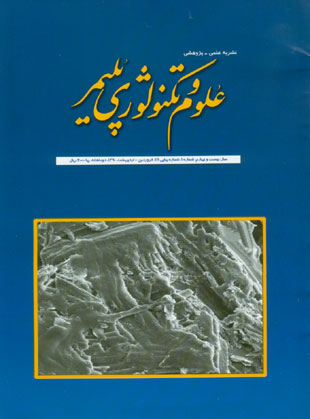فهرست مطالب

دو ماهنامه علوم و تکنولوژی پلیمر
سال بیست و چهارم شماره 1 (پیاپی 111، فروردین و اردیبهشت 1390)
- 80 صفحه، بهای روی جلد: 20,000ريال
- تاریخ انتشار: 1390/04/25
- تعداد عناوین: 5
-
-
Pages 3-31Polyurethane foams are extensively used in different applications such as furnituresand sandwich structures due to better mechanical properties, higheracoustic and damping behavior, higher resistance to hydrocarbon, and aging.With respect to flammability of polyurethane materials and safety precaution in livingand working environments there is a vital need to study and investigate publishedworks on thermal decomposition, combustion and fire retardancy of polyurethanematerials. Recently a new approach in improved applications of flame retardant additivesand nano-composite polyurethane has been met. In this review, the thermaldecomposition, combustion and fire retardancy of polyurethane foams are discussedand the effects of halogenic materials as flame retardants, inorganic compounds,blowing agents, phosphorus compounds in the form of organic and inorganic reactiveadditives, expandable graphite and new products based on nanocomposites areintroduced and classified.Keywords: polyurethane foam, flame retardant, thermal decomposition, combustion, nanocomposite
-
Pages 33-42Cotton/polyester knitted fabrics as a major production of textile industry was treated with titanium dioxide nanosized particles. The treated fabric with nanosized TiO2 became whiter with a good self-cleaning property. Also the discoloration of Reactive Black 5 dye was studied and reported. The stabilization of TiO2 on cotton/polyester knitted fabrics by citric acid (CA) with sodium hypophosphate (SHP) as a catalyst was also investigated. These samples showed a good self-cleaning property through discoloration of C.I. Direct Red 80. In addition, using CA in the presence of SHP, helped to stabilize the TiO2 nanosized particles on the fabric surface even after 10 washing cycles. The images of scanning electron microscopy and X-Ray mapping, EDX analyses confirmed the presence of TiO2 nanoparticles on the fabric surfaces even after 10 washing cycles.Keywords: nano TiO2, cotton, polyester, self-cleaning, stabilization, decolorization
-
Pages 43-53Mechanical properties of wood/plastic composites manufactured by polyethyleneand polypropylene blends (PP/HDPE) were studied. The SEBS (styrene-ethylene butylene-styrene) and EPDM (ethylene-propylene diene monomer) were used as compatibilizers to improve the compatibility and miscibility of the interface between HDPE and PP phases. The sawdust and polymers were compounded using an internal mixer (Haake). The samples of wood/plastic composite were prepared by injection-molding. Mechanical properties of wood/plastic composites such as, flexural modulus and flexural strength, impact strength and tensile strength were determined. The Taguchi method was employed in order to optimize these properties. Blends of PP and PE (3 levels), MAPP content (3 levels), polymer compatibilizer content (3 levels), polymer compatibilizer (two types) were considered as variable parameters. The results indicated that wood/plastic composites containing: 80% HDPE with 20% PP blend, 4% MAPP coupling agent, 2% polymer and EPDM compatibilizers were the optimum conditions to acquire the best quality composites. The fracture surfaces of samples were observed by scanningelectron microscopy.Keywords: wood, plastic composite, Polyethylene, polypropylene, compatibilizer, mechanical properties
-
Pages 55-67Water born poly(styrene-butyl acrylate)/clay nanocomposite latexes were synthesized by a novel initiating system of activators generated by electron transfer (AGET) in a system of atom transfer radical polymerization (ATRP). Initially, the clay was swelled in a mixture of styrene, butyl acrylate, and hexadecane. The mixture was then sonicated to obtain a stable miniemulsion. To synthesize poly(styrene-butyl acrylate)/clay nanocomposite latexes, the reducing agent (ascorbic acid) was added dropwise to the reactor (to reduce termination reactions). Particle size and particle size distribution of resulting nanocomposite latexes were determined by dynamic light scattering (DLS). These latex particles were produced with diameters in the size range of 138-171 nm. In addition, the increase in clay content led to increased particles size. Number and weight-average molecular weights of the resultant copolymer nanocomposites and their molecular weight distributions were determined by gel permeation chromatography. The narrow molecularweight distribution of the nanocomposites is an indication of a successful ATRP which was accomplished in miniemulsion formation. Using 1H NMR, copolymers were characterized and the mol ratios of monomers in copolymer composition were calculated. X-Ray diffraction and transmission electron microscopy results showed the mixed intercalated and exfoliated morphologies of nanocomposites in which homogeneous distributions of clay layers in the polymer matrix have been achieved.Keywords: AGET ATRP, nanocomposite, miniemulsion, poly(styrene-co-butyl acrylate), aqueouse latex
-
Pages 69-78Fiber/ metal laminates (FMLs) are hybrid composites consisting of alternating thin layers of metal sheets and fiber reinforced epoxy laminates. In this study, the effect of fiber orientation on impact properties of FML plates is investigated both analytically and experimentally. Two groups of specimens were prepared and tested in two different levels of impactor energy. The indentation depth and damage size after impact is measured and delamination area is specified for each specimen. Increasing impactor energy causes more fractured layers, more debonding and delaminations area but the trend was similar to lower level energy. The analysis was based on a method of minimum total potential energy and the von Karman strain displacement equations. Good agreement is obtained between the model predictions and experimental results.

